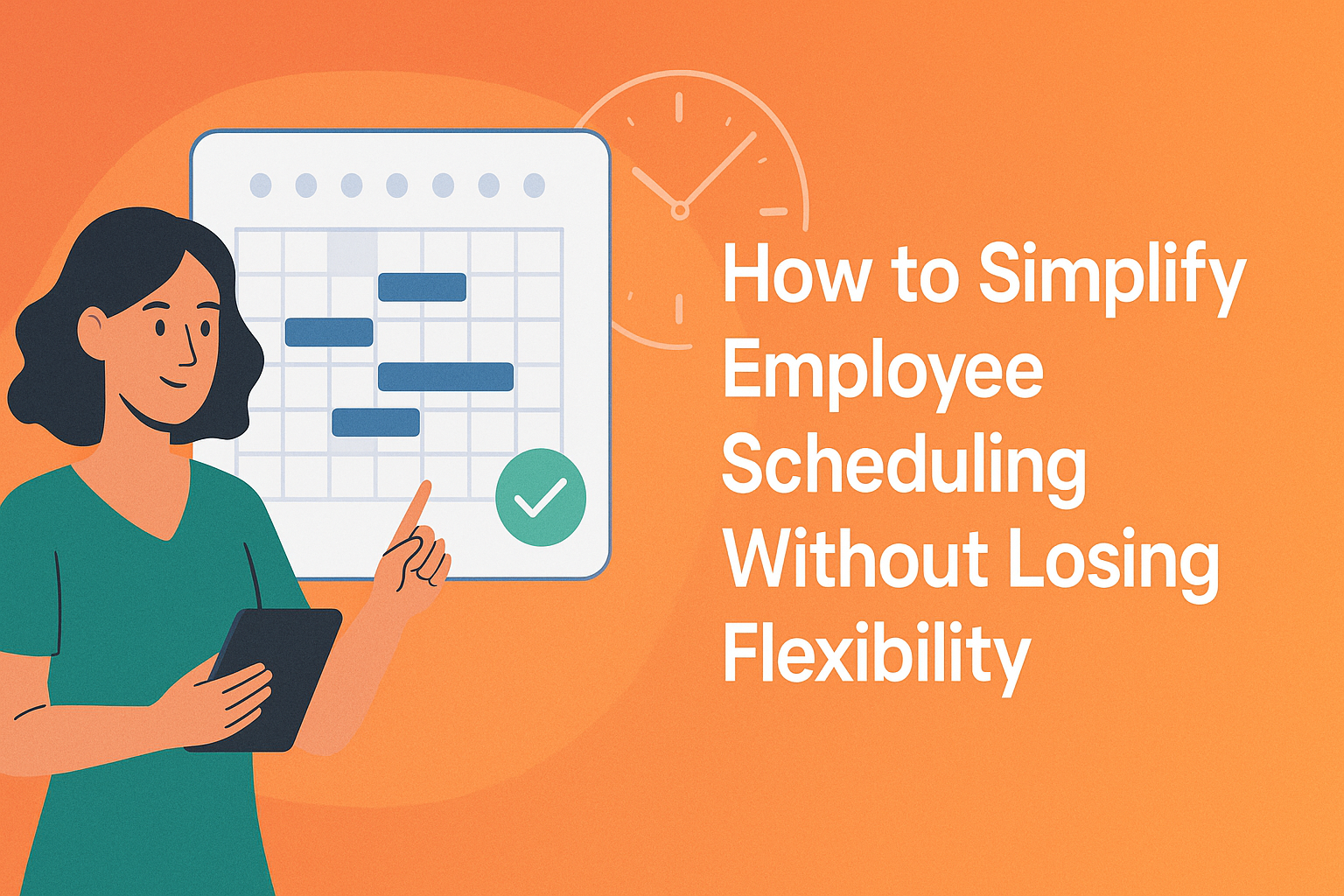How to Simplify Employee Scheduling Without Losing Flexibility
Learn practical ways to simplify employee scheduling without losing flexibility. Discover modern HR tools and techniques that make workforce m



Introduction: The Scheduling Paradox
Ask any HR manager or team leader what the hardest part of operations is, and chances are, they’ll say scheduling.
Balancing employee preferences, legal requirements, business needs, and last-minute changes feels like solving a Rubik’s Cube that never stops moving. On paper, scheduling seems simple: assign shifts, fill gaps, and keep coverage balanced. In reality, it’s one of the most time-consuming, conflict-prone processes in HR.
The problem isn’t just complexity — it’s the fact that flexibility is no longer optional. Employees expect adaptable schedules that respect their time, personal lives, and mental well-being. But HR still needs predictability and consistency.
This article explores how to simplify employee scheduling without losing flexibility — using smarter processes, clear communication, and the right technology.
The True Cost of Complicated Scheduling
When scheduling is managed manually — through spreadsheets, emails, or printed rosters — it eats up time and causes friction.
Common issues include:
- Overlapping shifts that create confusion or conflict.
- Coverage gaps when last-minute absences aren’t communicated quickly.
- Burnout because the same employees keep getting “voluntold” for extra hours.
- Low morale when employees feel ignored or overworked.
A study by the Workforce Institute found that 49% of employees would leave their job if they felt their schedule was unfair or inflexible.
In short, poor scheduling isn’t just an operational issue — it’s an HR risk. And yet, it’s entirely preventable.
Why Flexibility Matters More Than Ever
The modern workforce values flexibility almost as much as pay. Hybrid work, remote policies, and diverse family needs have redefined what “normal” scheduling looks like.
For HR, this means one thing: you can’t just optimize for business efficiency — you have to optimize for mutual trust.
Flexible scheduling leads to:
- Better employee engagement and retention.
- Reduced absenteeism and unplanned leave.
- Improved mental health and work-life balance.
- Higher productivity during on-site or focused work periods.
The challenge is to deliver flexibility without chaos. That’s where modern scheduling tools and clear structures come in.
The Power of Transparent Communication
Simplifying scheduling starts with transparency. Employees shouldn’t feel like their shifts are decided in a black box. Clear communication builds trust and reduces last-minute surprises.
Here are three proven habits of HR teams that excel at scheduling communication:
- Publish schedules early — ideally two to four weeks in advance.
- Centralize access — one platform or app where employees can always view the latest version.
- Automate notifications — changes should trigger automatic updates via mobile or email.
Modern systems like Schemon make this process effortless. Instead of sending out multiple versions of a schedule or chasing confirmations, HR can post updates once — and every employee instantly sees it.
Transparency doesn’t just save time; it builds accountability and inclusion.
Simplify with Rules and Parameters
Paradoxically, the best way to stay flexible is to set clear boundaries. Schedules shouldn’t be made from scratch each week — they should follow logical, consistent rules.
For example:
- Define maximum weekly hours to prevent overwork.
- Ensure rest time between shifts to comply with regulations.
- Set skill-based assignments so the right people are always scheduled.
- Automate rotation patterns for fairness in weekend or night shifts.
When these parameters are built into your scheduling system, flexibility becomes structured — not chaotic. Employees can swap shifts or request changes within a framework that keeps HR and compliance happy.
Schemon’s scheduling engine, for instance, allows HR teams to create templates and apply consistent rules across departments while still letting employees personalize their availability.
Use Technology to Handle the Details
Let’s be honest — no human can perfectly manage dozens or hundreds of variables at once. Technology can.
Smart scheduling software automatically checks availability, calculates hours, and flags potential conflicts before they happen.
It can:
- Suggest the most efficient coverage pattern.
- Auto-fill recurring shifts based on demand.
- Track overtime and leave balances in real time.
- Integrate with payroll to calculate accurate wages.
Instead of reacting to problems, HR teams can focus on fine-tuning outcomes.
When you adopt a platform like Schemon, scheduling becomes a collaborative, data-driven process rather than a manual burden. HR sets the parameters, the system handles the repetition, and employees stay informed and empowered.
Keep Flexibility Where It Belongs — in the Employee’s Hands
True flexibility isn’t about HR doing more; it’s about employees doing more themselves — with the right tools.
Self-service scheduling portals are one of the most powerful shifts in HR tech over the last decade. They allow employees to:
- View and acknowledge shifts.
- Request changes or swaps within policy.
- Set their preferred availability.
- Receive instant updates when schedules change.
This level of autonomy creates a culture of responsibility. Employees feel trusted, and HR gains time back. It’s the definition of a win-win.
Balancing Flexibility and Business Needs
Every organization has its limits. The trick is to find the right equilibrium between what employees want and what operations demand.
Here’s a simple framework for balance:
- Start with the data. Look at past attendance, peak workloads, and staff ratios to identify real flexibility zones.
- Prioritize fairness. Use rules and rotation to ensure equal access to preferred shifts.
- Empower team leads. Give managers authority to approve or deny swaps quickly, reducing delays.
- Listen actively. Conduct short quarterly feedback surveys to improve scheduling satisfaction.
Platforms like Schemon make this balancing act easier because they track both business requirements and employee preferences in one system.
A Culture of Predictability and Respect
Simplified scheduling isn’t about rigid rules or cutting corners — it’s about predictability.
When people know their schedules in advance and can rely on consistent processes, stress drops and productivity rises. Predictability is one of the most underrated forms of respect in modern workplaces.
HR automation supports this by removing the guesswork and last-minute panic. Employees can plan their lives, and HR can plan for success.
Real Example: Turning Scheduling Chaos into Calm
A mid-sized logistics firm recently adopted Schemon after years of managing shifts manually through shared spreadsheets.
Before: 12 HR staff spent three full days each month building and verifying schedules. Errors were common, and morale was low.
After automation: scheduling now takes less than two hours, employees can swap shifts through an app, and absenteeism dropped by 18% in three months.
That’s the tangible power of simplifying scheduling with structure and the right toolset.
The Future of Scheduling: Predictive and Employee-Centric
As HR tech advances, scheduling will become predictive — systems will anticipate needs before you plan them.
Imagine:
- AI detecting potential understaffing based on past patterns.
- Automatic alerts before employees exceed hour limits.
- Data-driven insights into optimal staffing for productivity.
This future isn’t far away. Companies like Schemon are already designing adaptive scheduling systems that evolve with workforce behavior and company demand.
Conclusion: Simplicity Is the New Smart
Simplifying scheduling doesn’t mean losing flexibility — it means redefining it. The goal isn’t to remove choice but to make choice manageable for everyone involved.
With transparent communication, structured flexibility, and automation, HR can reclaim hours each week and build happier, more productive teams.
The truth is, scheduling will always be complex — but it doesn’t have to feel that way.
Schemon helps HR teams automate scheduling, improve transparency, and empower employees to manage their own flexibility — all within one secure, easy-to-use platform. Visit schemon.com to discover how smart scheduling can simplify your HR life.











